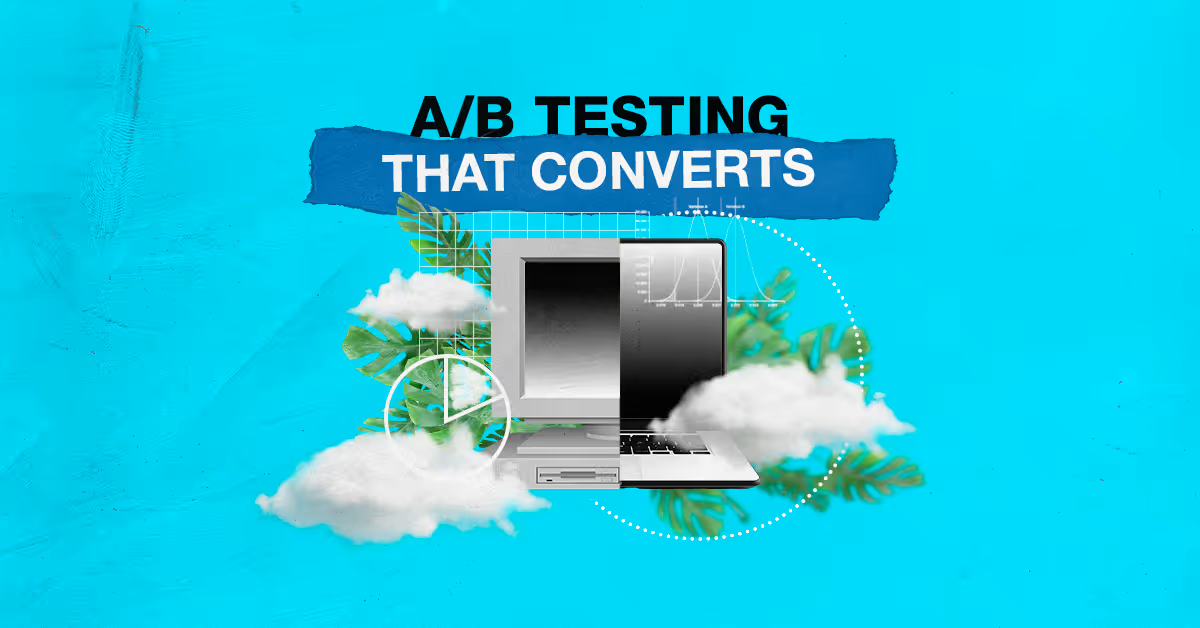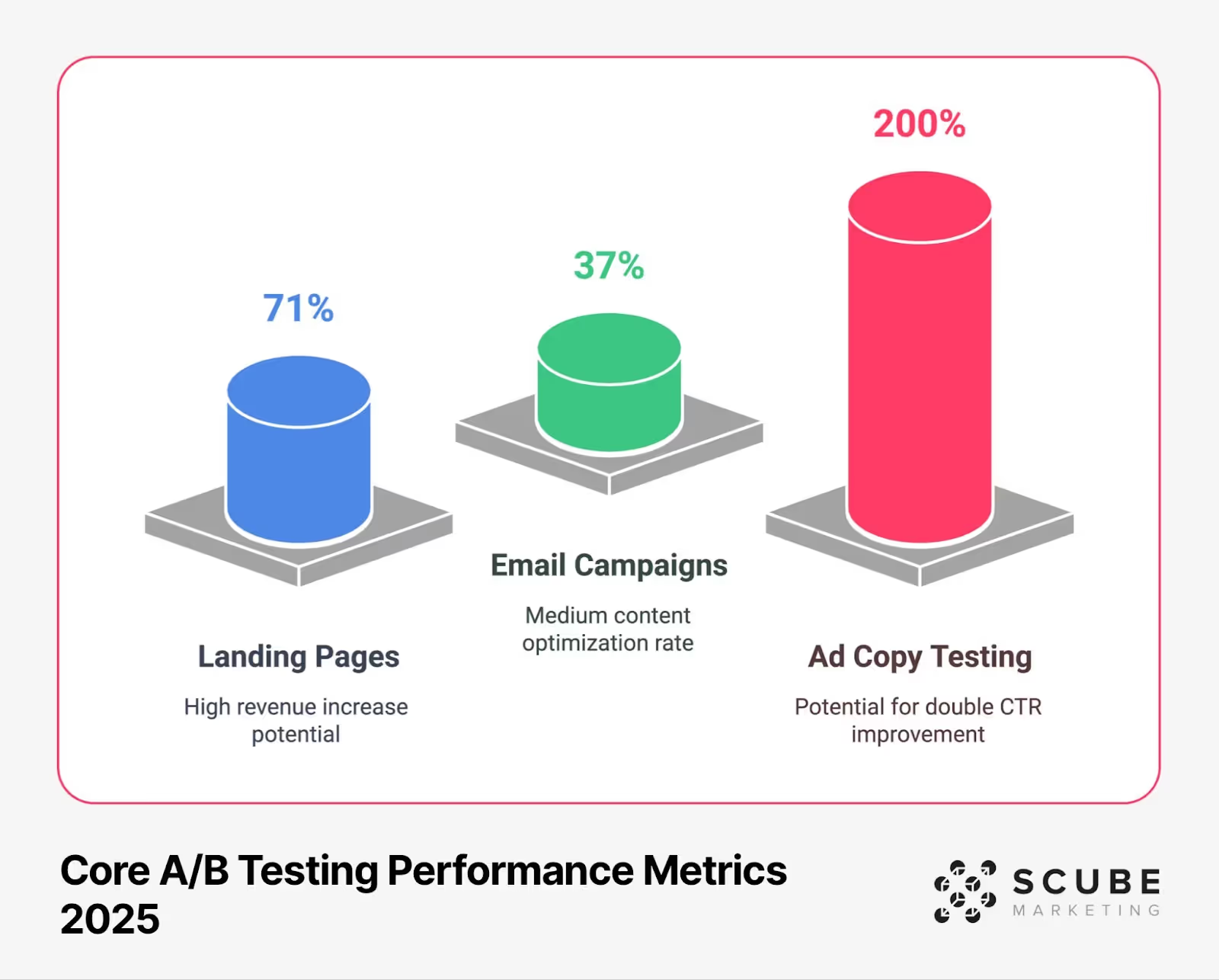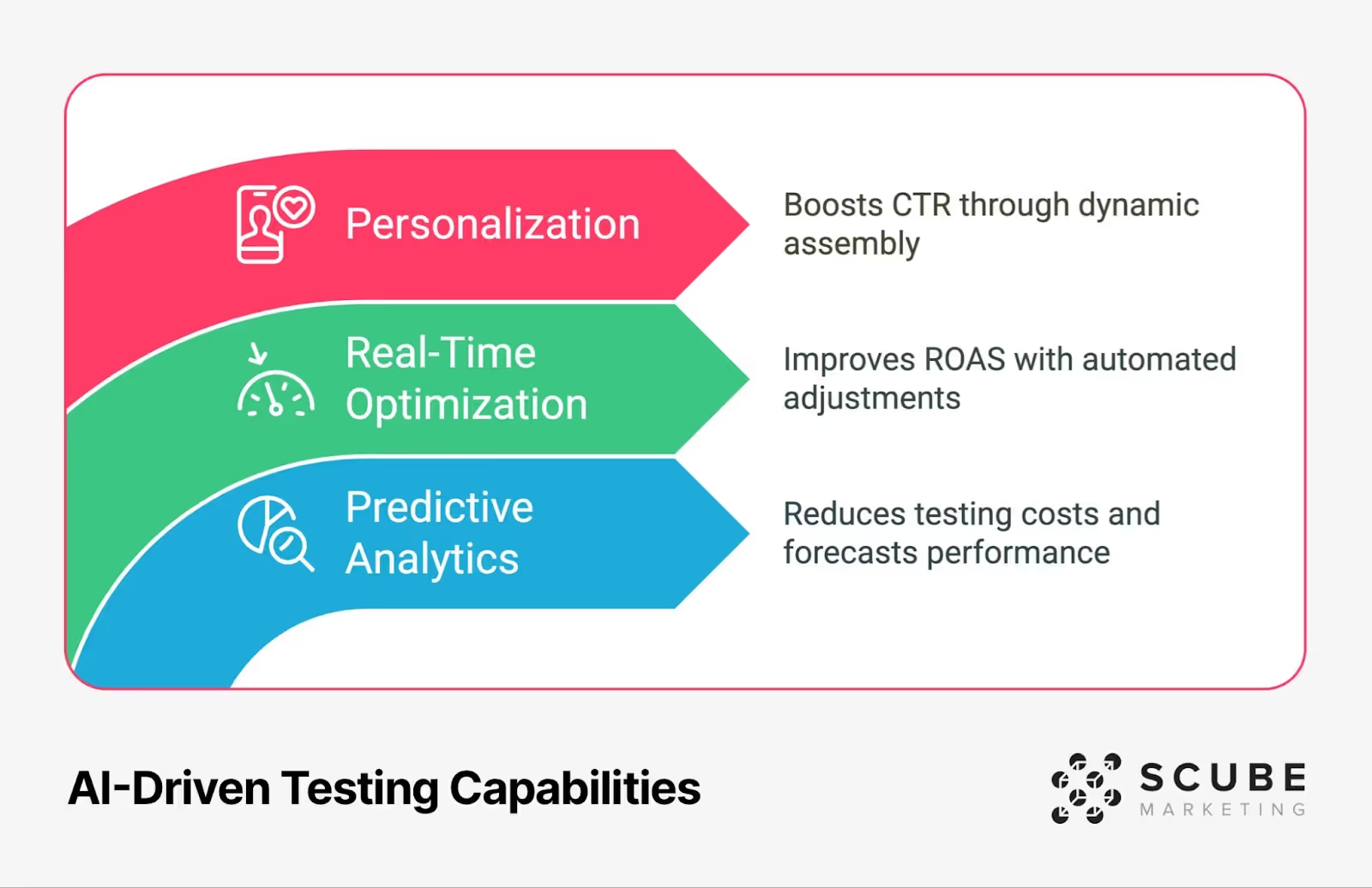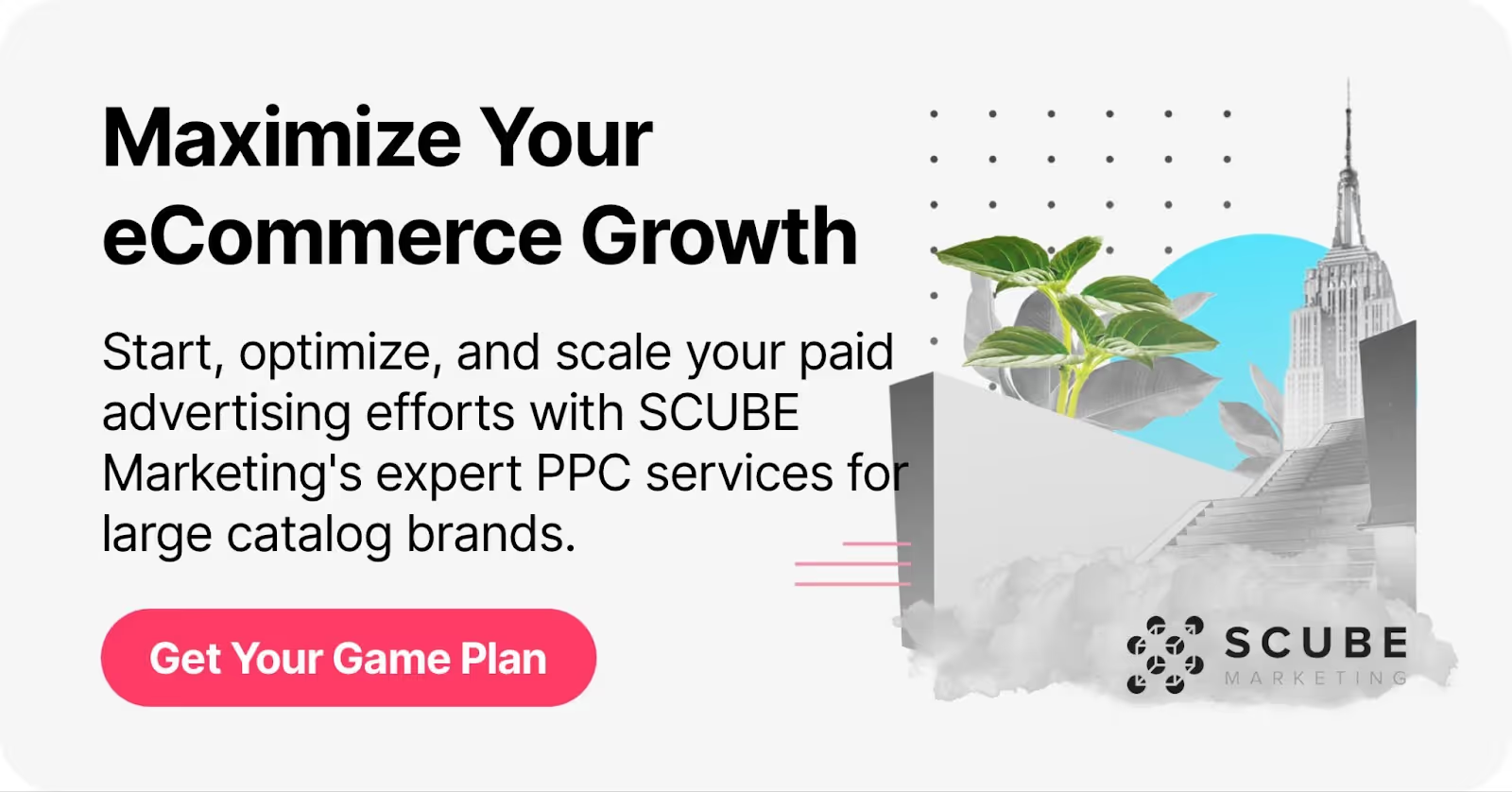
A/B testing in advertising isn't just about testing button colors anymore. With 77% of marketers utilizing advanced testing methods, the game has fundamentally changed (Source: LLC Buddy).
The difference between profitable campaigns and wasted ad spend often comes down to how effectively you're testing and optimizing your advertising elements.
We've managed over $50M in ad spend across large-catalog retailers, and one thing becomes crystal clear: businesses that implement systematic testing protocols consistently outperform those relying on gut instinct. The key lies in combining traditional testing fundamentals with emerging AI-driven approaches to create a comprehensive optimization strategy.
This guide breaks down data-driven A/B testing strategies that are delivering real results in 2025. We'll show you exactly how to implement each one, backed by concrete data and real-world applications from our work with automotive, B2B, and D2C sectors.
Ready to transform your advertising performance? Let's examine each strategy in detail, starting with where A/B testing stands in 2025 and why it matters more than ever for your bottom line.

The A/B testing landscape has evolved dramatically, with the market projected to reach USD 1249.57 Million by 2028 (Source: Mailmodo). This explosive growth isn't just about market size—it reflects a fundamental shift in how businesses approach advertising optimization. Through our work with enterprise-level eCommerce analytics, we're seeing this transformation firsthand.
What's particularly striking about these numbers is their consistency across different industries. Whether you're running Google Shopping campaigns or social media ads, systematic testing consistently delivers measurable improvements in performance metrics.
The most significant shift we're observing in 2025 is the integration of testing protocols across all advertising channels. This isn't just about running isolated tests anymore—it's about creating a comprehensive testing ecosystem that drives continuous improvement. Our experience managing large-scale PPC campaigns shows that businesses implementing systematic testing protocols typically see a 25-40% improvement in ROAS within the first quarter.
However, the reality check comes from understanding that only about 1 in 8 A/B tests yield significant positive results (Source: Picreel). This statistic isn't discouraging—it's actually illuminating. It underscores why having a structured approach to testing is crucial. Those successful tests often lead to breakthrough improvements that more than justify the investment in the testing process.
The key to success lies in understanding that A/B testing in 2025 isn't just about making incremental improvements. It's about building a data-driven decision-making framework that continuously optimizes your advertising performance. This approach has become particularly crucial for eCommerce PPC strategy, where even small improvements in conversion rates can translate into significant revenue gains.
While AI and machine learning grab headlines, traditional A/B testing strategies remain powerfully effective when executed properly. Our data shows that 85% of successful businesses prioritize testing core elements like CTAs and landing pages (Source: VWO). The key is knowing which traditional methods deliver the highest ROI and how to implement them effectively.
Through our work with large-catalog retailers, we've identified three core areas where traditional split testing consistently delivers substantial returns:
The power of these fundamentals lies in their ability to provide clear, actionable data. When managing PPC ad testing, we consistently see that methodical split testing of these elements can double click-through rates and significantly improve conversion rates.
While split testing examines individual elements, multivariate testing allows us to understand how different combinations of elements work together. This becomes particularly crucial in complex advertising environments where multiple variables influence conversion rates.
Here's how we approach multivariate testing for our enterprise clients:
The key to successful multivariate testing lies in maintaining statistical significance while testing multiple variables. Through our eCommerce PPC analytics work, we've found that focusing on high-traffic segments first allows for faster, more reliable results.
For example, when working with an automotive parts retailer, we implemented a systematic multivariate testing program that examined combinations of:
This methodical approach to traditional testing delivered a 32% improvement in conversion rates within 60 days. The success wasn't just in the testing itself—it was in the systematic application of proven testing methodologies combined with rigorous data analysis.
What makes these traditional methods particularly valuable in 2025 is their ability to provide clear, actionable insights that directly inform your advertising strategy. While newer technologies offer exciting possibilities, mastering these fundamental testing approaches creates a solid foundation for more advanced optimization efforts.
The integration of AI into A/B testing has revolutionized how we approach advertising optimization. Major platforms are already seeing the impact—Bing reported a 25% increase in ad revenue through AI-enhanced testing methods (Source: FinancesOnline). Through our experience managing complex PPC campaigns, we've identified three game-changing AI-driven strategies that are delivering exceptional results.

Predictive analytics has transformed how we approach testing by allowing us to forecast performance outcomes before committing significant ad spend. Here's how we're implementing this technology for our enterprise clients:
AI-driven personalization has moved beyond simple demographic targeting. We're now implementing dynamic content optimization that adapts in real-time based on user behavior patterns. This approach involves:
Through our work with automotive clients, we've seen how AI-powered personalization can transform campaign performance. For instance, implementing dynamic product recommendations based on user behavior patterns has consistently delivered 40-50% improvements in click-through rates.
The traditional approach of running individual tests has given way to continuous, AI-powered optimization. This new methodology enables:
Real-time performance monitoring and adjustment has become crucial for campaign structure optimization. Instead of waiting for tests to conclude, AI systems continuously analyze performance data and make incremental improvements. This approach has proven particularly effective in competitive markets where rapid adaptation is essential.
For example, when managing large product catalogs, our AI-driven testing systems automatically:
The power of AI-driven testing lies in its ability to process and act on vast amounts of data in real-time. While traditional testing methods remain valuable for strategic decisions, AI-powered testing has become essential for maintaining competitive advantage in rapidly evolving markets.
Through our experience with bid strategy optimization, we've found that combining AI-driven testing with human strategic oversight delivers the best results. The key is understanding where AI can automate routine optimization tasks while maintaining human control over strategic decisions.
Successful A/B testing implementation directly correlates with revenue growth—71% of businesses report increased sales after implementing systematic testing protocols (Source: Infinity Concepts). Through our experience managing large-scale PPC campaigns, we've developed a proven framework that consistently delivers results.
Every successful testing program starts with clearly defined objectives. Here's our strategic approach to goal setting:
When implementing tests for our B2B clients, we ensure each test aligns with specific business objectives while maintaining focus on overall campaign performance metrics.
The foundation of reliable testing lies in proper statistical analysis. Our implementation framework includes:
Through our work with product feed optimization, we've developed specific guidelines for test duration based on traffic volume:
For high-traffic campaigns (10,000+ daily impressions):
For medium-traffic campaigns (1,000-10,000 daily impressions):
The key to successful implementation lies in maintaining rigorous testing protocols while remaining flexible enough to adapt to changing market conditions. Our experience with eCommerce analytics shows that businesses often fail not in the testing itself, but in the proper implementation of testing protocols.
Implementation success requires three core elements:
By following this structured approach to implementation, we consistently see improvements in campaign performance metrics across all advertising channels. The key is maintaining the discipline to follow proper testing protocols while remaining agile enough to act on insights quickly when opportunities arise.

The reality of A/B testing is sobering: only 1 in 8 tests yield significant positive results (Source: Picreel). Through our experience managing PPC ad testing for enterprise clients, we've identified the critical pitfalls that often lead to test failure—and more importantly, how to avoid them.
The most costly mistakes often occur in three key areas:
Through our work with eCommerce PPC strategy, we've developed specific protocols to address these challenges before they impact campaign performance.
Success in A/B testing requires more than just avoiding mistakes—it demands a proactive approach to quality control. Here's our framework for maintaining testing integrity:
Pre-Test Validation:
During-Test Monitoring:
Post-Test Analysis:
When managing campaign structures, we've found that most testing failures stem from rushing implementation without proper validation. The key is maintaining a systematic approach while remaining vigilant for potential issues.
Here are the critical checkpoints we use to ensure testing success:
Through our experience with analytics and optimization, we've learned that successful A/B testing isn't just about running tests—it's about maintaining the integrity of your testing program through rigorous quality control measures.
The A/B testing landscape is evolving rapidly, with a projected CAGR of 11.62% through 2028 (Source: Mailmodo). Through our work with enterprise PPC strategy, we're seeing several transformative trends that will reshape testing methodologies in the coming years.
The future of A/B testing lies in the convergence of multiple technologies and approaches:
Machine Learning Integration:
Cross-Channel Testing:
Through our experience with eCommerce optimization, we're already implementing many of these advanced testing methodologies, seeing significant improvements in campaign performance.
To stay ahead of the curve, businesses need to focus on three key areas:
The integration of advanced analytics with testing platforms will enable more sophisticated optimization strategies. We're already seeing this in action with our enterprise clients, where automated testing systems are delivering unprecedented levels of personalization and performance.
To position your advertising programs for success in this evolving landscape, focus on:
Through our work with automotive and B2B clients, we're seeing that businesses that invest in these areas now are positioning themselves for significant competitive advantages in the coming years.
A: Test duration depends on traffic volume and conversion rates. For high-traffic campaigns (10,000+ daily impressions), run tests for at least 14 days. For medium-traffic campaigns, extend to 30 days minimum to ensure statistical significance.
A: Aim for at least 100 conversions per variation in high-traffic campaigns, and 50+ conversions in medium-traffic campaigns. This ensures sufficient data for statistically significant results.
A: Implement automated testing for routine optimizations while maintaining human oversight for strategic decisions and creative elements. Regular review of automated testing results ensures alignment with business objectives.
A: Focus on metrics that directly impact business goals: ROAS, conversion rates, and CPA for performance campaigns; CTR and engagement rates for awareness campaigns.
Ready to transform your advertising performance through advanced A/B testing? Contact our team to learn how we can help implement these strategies for your business.